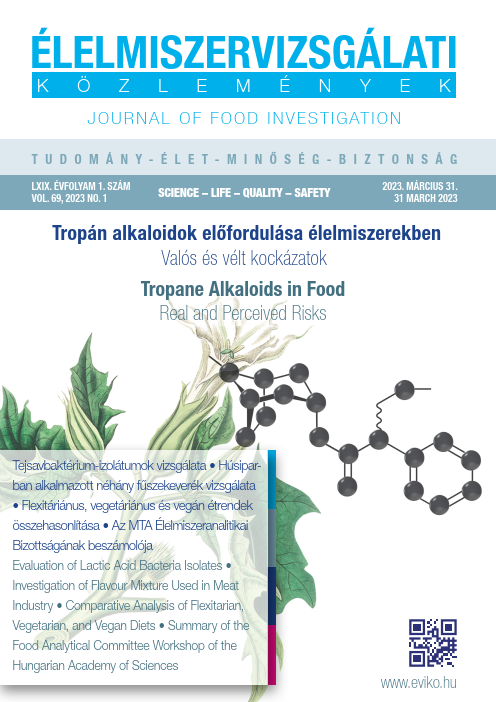Identification of Quality of Complex Flavour Mixtures Used in Meat Industry
Main Article Content
Absztrakt
Multifunctional complex flavour mixtures, which simplify and speed up food production, are of great importance in the meat processing industry. The aim of the research was to identify the quality of complex food spice mixes prepared by a producer. It was found that the compositions of the grill spice mix met the regulations in terms of organoleptic, physical, and chemical parameters. The garlic mixture sample revealed the presence of edible salt, not declared by the manufacturer. Dietary fiber was present in all the mixes under study. Garlic 1:6 sample differed from the other complex additives by the increased content of Al, Li, Mg, P, Si, Sr, Te, as well as the presence of Mo, Ti, V, and W. The ‘grill spice mix’ had relatively high amounts of Ca, Cr, and Fe, but did not contain detectable amount of Si, declared by the manufacturer as part of E551. The composition of the grill spice mix stood out because of the high content of Mn, Na, and Zn, an aroma mixture – Cu. It should be noted that E627 and E631 flavor enhancers were found in an aroma mixture, whereas E450 stabilizer and emulsifier was found in a grill aroma mixture. According to a number of experts, these components pose a threat to the human body as they can cause intestinal and stomach disorders. In this regard, it is necessary to understand which food additives need to be excluded from a person’s diet, which are especially dangerous, and which are safe to consume from time to time in small quantities as part of meat products.
Letöltések
Article Details

This work is licensed under a Creative Commons Attribution-NonCommercial-NoDerivatives 4.0 International License.
Hivatkozások
Agapkin, A. M. (2021): A little more on the classification and brief description of food additives. Food Products Commodity Expert, 5, pp. 382-386. https://doi.org/10.33920/igt-2105-07
Kantsurova, E. S., Kozlikin, A. V. (2020): The use of food additives in the production of semi-finished meat products. Electronic scientific journal, 5(34), pp. 24-26.
Belyaeva, M. A., Gulvansky, R. A., Spassky, K. G. (2019): The role of food additives in the production of minced meat semi-finished products. Food Industry, 3, pp. 54-57.
Krasulya, O. N., Shumsky, Yu. A., Pechurina, O. P. (2021): Experience in the implementation of management systems in the production, storage, and sale of food additives. Meat Industry, 2, pp. 18-22.
Zharinov, A. I., Kuznetsova, O. V. (2021): Food additives and ingredients: features of use in technology of meat products. Meat technologies, 2(218), pp. 30-33. https://doi.org/10.33465/2308-2941-2021-05-30-35.
Andreenkov, V. A., Alekhina, L. V., Mansvetova, E. V. (2015): New complex food additives for semismoked and boiled-smoked sausages. Meat Industry, 9, pp. 16-18.
Bisemalieva, H. F. (2021): Food additives, their impact on human health. Eurasian Scientific Association, 2-3 (72), pp. 142-143.
Maksimov, G. G., Aznabaeva, Yu. G., Zapasnaya, A. V. (2020): Food additives as a risk factor for exacerbation of chronic diseases. Diary of the Kazan medical school, 3 (29), pp. 31-42.
Ablyamitova, K. R., Letyagina, E. N. (2020): Food additives and food safety. Agri-food policy of Russia, 4, pp. 2-5.
Tolstova, N. Yu., Kuznetsova, R. V. (2020): Food additives and their impact on human health. Science and Education, 3(3), p. 293.
Agapkin, A. M., Ibragimova, N. A. (2021): Prohibited food additives: rationing, side effects, liability for violation of the law. Economy and Entrepreneurship, 2(127), pp. 1121-1124. https://doi.org/10.34925/EIP.2021.127.2.224.
Skurikhin, I. M., Tutelyan, V. A. (1998): Guide to methods for analysis of food quality and safety. Moscow,Brandes, Medicine, 342 p.
Mokretsov, I. V., Sidorov, S. A. (2018): Substantiation of the level of salt introduction into minced meat of fermented sausages for baby food. Resource saving environmentally friendly technologies for storage and processing of agricultural products: Collection of articles based on the materials of the international scientific-practical conference dedicated to the 75th anniversary of the Kurgan region. pp. 329-333.
Pryanishnikov, V. V. (2016): Food fibers in the technology of semi-finished meat products. Rational nutrition, food additives and biostimulants, 5, pp. 25-26.
Tyurina, L. E., Tabakov, N. A. (2011): Production technology of functional meat products. Krasnoyarsk, Krasnoyarsk State Agrarian University, 102 p.
Sidelnikova, N. A., Smirnova, V. V. (2019): Resource-saving technologies of deep processing of garlic. Innovations in the agro-industrial complex: problems and prospects, 4 (24), pp. 253-262.
Sidorenko, T. A. (2009): The use of local fruit and berry raw materials in the production of natural food additives [Belarus]. Food and processing industry. Abstract journal, 1, p. 223.

